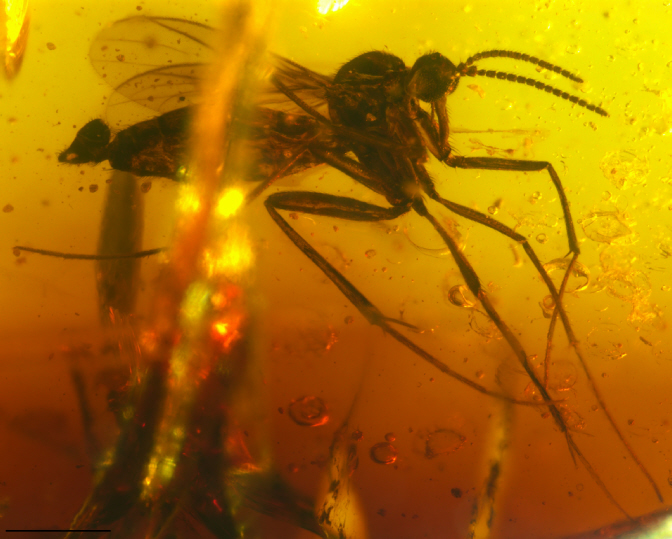


A new species of fungus gnat in Indian amber closely resembles its fossil relatives from Europe, disproving the concept of a strongly isolated Indian subcontinent. Researchers have identified three new species of insects encased in Cambay amber dating from over 54 million years ago in a new study published by PeerJ.
The three insects discovered are new species of fungus gnats. One species, Palaeognoriste orientale, provides further clues to India´s plate tectonic history. Fossils found in Indian amber closely resemble fossil relatives from Europe providing further evidence of regular faunal exchange between India and Europe while disproving the concept of a strongly isolated Indian subcontinent.
New fossils found in Indian amber are disproving the concept of a strongly isolated Indian subcontinent
Share this page
The fossils are long beaked fungus gnats (Lygistorrhinidae). The name of this group refers to one of their most conspicuous characters: an elongated proboscis, which is presumably for feeding from flowers. This small family of tropical flies is known by only seven fossil and eight living genera. Given the rareness of this group Indian amber has revealed a surprising diversity with three species in three different fossil and modern genera. This even exceeds the number of known species in the well-studied Baltic amber, from which only two species are reported.
Cambay amber from India has only been studied for a few years, but is already providing an important role in uncovering secrets regarding the origins of India´s fauna. For many years, the well-established theory stated that India formed an isolated continent during its drift, allowing a highly endemic biota to develop. However, flies and other insects entrapped in Indian amber continue to reveal faunal connections to different epochs and regions of the world.
The Plate Tectonic theory predicts that India was isolated and heading north towards Asia 54 million years ago so the exact mechanisms of faunal exchange remain unclear. One suggestion is that dispersal might have been facilitated by an island chain system between India and Asia allowing the insects to island hop between them.
There is another solution to this paradox. Last year there was a geological science paper in the Journal of Applied Geology and Geophysics (IOSR-JAGG) were the authors concluded that several lines of geological evidence indicate “the envisaged movement of the Indian landmass is untenable”, even though this movement is essential for the Plate Tectonic theory. They proposed that the answer to this paradox is that the Earth was a smaller diameter in the past as suggested by the expanding Earth theory. Comparisons of Plate and Expansion Tectonic reconstructions show a major difference in the development of the Indian region. Expansion would allow India to remain closely connected to Asia just as the evidence from this new species of fungus gnat indicates.
Cambay amber from India has only been studied for a few years, but is already providing an important role in uncovering secrets regarding the origins of India´s fauna. For many years, the well-established theory stated that India formed an isolated continent during its drift, allowing a highly endemic biota to develop. However, flies and other insects entrapped in Indian amber continue to reveal faunal connections to different epochs and regions of the world.
The Plate Tectonic theory predicts that India was isolated and heading north towards Asia 54 million years ago so the exact mechanisms of faunal exchange remain unclear. One suggestion is that dispersal might have been facilitated by an island chain system between India and Asia allowing the insects to island hop between them.
There is another solution to this paradox. Last year there was a geological science paper in the Journal of Applied Geology and Geophysics (IOSR-JAGG) were the authors concluded that several lines of geological evidence indicate “the envisaged movement of the Indian landmass is untenable”, even though this movement is essential for the Plate Tectonic theory. They proposed that the answer to this paradox is that the Earth was a smaller diameter in the past as suggested by the expanding Earth theory. Comparisons of Plate and Expansion Tectonic reconstructions show a major difference in the development of the Indian region. Expansion would allow India to remain closely connected to Asia just as the evidence from this new species of fungus gnat indicates.
Comment on Facebook about this page
Related Pages
The Concept of Gondwanaland and Pangaea
Was there an ancient ocean between India and Asia?
The history of the concept of the Tethys Ocean
How did life migrate across the ancient Pacific?
An index of Interesting Publications
Latest News Comments and Updates
A Brief History of the Expanding Earth theory
References
F, H, J, D.A. (2017) Lygistorrhinidae (Diptera: Bibionomorpha: Sciaroidea) in early Eocene Cambay amber. PeerJ 5:e3313 Abstract & Free pdf
, Z.A., & , R.C. 2016. The Concept of Gondwanaland and Pangaea: A reappraisal. Journal of Applied Geology and Geophysics (IOSR-JAGG).
Free pdf or Free pdf
YouTube Video - Plate Tectonics and Expansion Tectonics Compared
Page last updated 05 Jun 2025
Wayback

Palaeognoriste orientale, a new species of Lygistorrhinidae in Indian amber, which has its closest relatives in European Baltic amber. Scale bar: 0.5 mm. Image credit: Frauke Stebner




